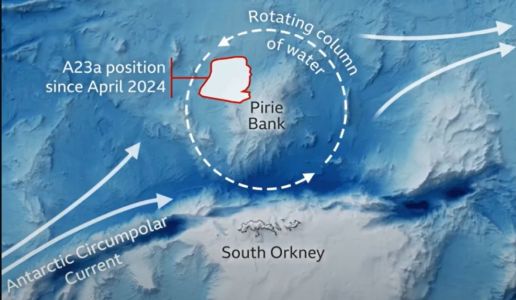 In January, we posted about an iceberg designated A23a, the world’s largest, which had begun to drift on the Antarctic Circumpolar Current into “iceberg alley.” As it drifted, it was being eroded by waves and melting in the relatively warmer waters of the Southern Ocean. The impact of the waves carved huge arches and caves in the 400-meter-high walls of the iceberg.
In January, we posted about an iceberg designated A23a, the world’s largest, which had begun to drift on the Antarctic Circumpolar Current into “iceberg alley.” As it drifted, it was being eroded by waves and melting in the relatively warmer waters of the Southern Ocean. The impact of the waves carved huge arches and caves in the 400-meter-high walls of the iceberg.
The expectations were that the berg would continue to melt as it drifted and would begin to break up, with luck, missing the British Overseas Territory of South Georgia.
Instead, A23a went precisely nowhere, as reported by the BBC. It remains in place just north of South Orkney Islands, turning in an anti-clockwise direction by about 15 degrees a day. And as long as it does this, its decay and eventual demise will be delayed.
Since April, A23a has been stuck in a massive oceanic eddy or vortex, a huge rotating cylinder of water that oceanographers call a Taylor Column. The phenomenon was first described by Prof GI Taylor, who showed how a current that meets an obstruction on the seafloor can – under the right circumstances – separate into two distinct flows, generating a full-depth mass of rotating water between them.
In this instance, the obstruction is a 100km-wide bump on the ocean bottom known as Pirie Bank. The vortex sits on top of the bank, and for now, A23a is its prisoner.
A23a is already known for its longevity. In 1986, the massive iceberg, more than three times larger than New York City, calved off West Antarctica’s Filchner-Ronne Ice Shelf and immediately grounded on the floor of the Weddell Sea, where it remained stuck for almost four decades until it broke free in late 2023.
“Usually you think of icebergs as being transient things; they fragment and melt away. But not this one,” observed polar expert Prof Mark Brandon. “A23a is the iceberg that just refuses to die,” the Open University researcher told BBC News.
Thanks to Alaric Bond for contributing to this post.
